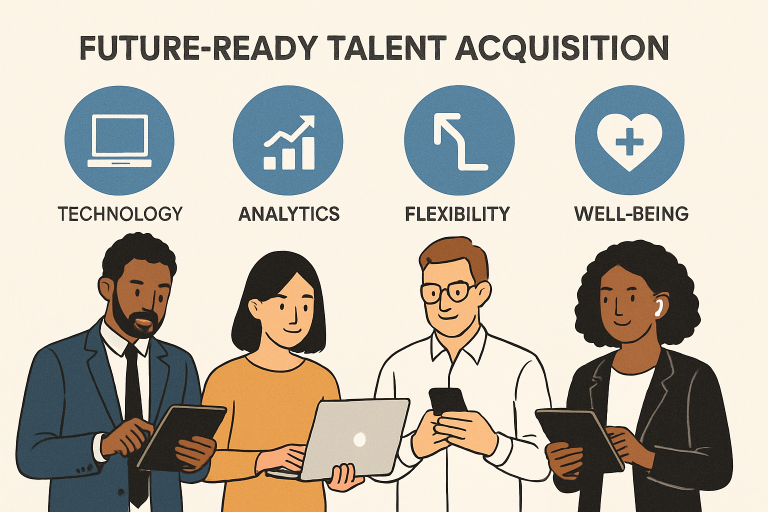Key Takeaways
- Integrating AI and automation enhances recruitment efficiency by streamlining rote tasks and improving candidate matching.
- Flexible workforce models equip organizations to manage economic volatility, optimize costs, and access targeted skill sets as needed.
- Placing emphasis on employee well-being helps organizations attract, engage, and retain top talent while bolstering their reputations.
- Data-driven decision-making empowers employers to refine hiring processes with actionable, evidence-based insights.
- Continuous upskilling ensures a workforce that stays relevant and adaptable amid technological and business changes.
Table of Contents
- Introduction
- Leveraging AI and Automation in Recruitment
- Adopting Flexible Workforce Models
- Prioritizing Employee Well-being
- Implementing Data-Driven Decision-Making
- Investing in Continuous Upskilling
Introduction
As workforce dynamics rapidly evolve in today’s hyper-connected world, organizations must revamp their talent acquisition strategies to anticipate change and stay ahead of competitors. Rapid technological advances and shifting global economic conditions compel businesses to reconsider how they attract, hire, and retain employees. Embracing innovative technologies can fundamentally transform how employers identify, attract, and engage high-quality candidates through every stage of the talent lifecycle. Utilizing tools like people analytics software empowers HR teams to make more effective, data-driven decisions that drive immediate hiring outcomes and contribute to long-term business growth and success.
Today’s job market is highly volatile, marked by economic uncertainty, changing social expectations, and relentless technological progress. These trends demand a fresh, agile approach to securing and nurturing top talent. Companies that proactively strengthen their hiring processes with data analytics, well-being initiatives, and adaptable workforce models not only fill roles effectively but also build resilient, forward-thinking teams equipped to handle the unknowns of tomorrow. Employees and candidates alike are attracted to organizations that demonstrate an ability—and willingness—to change with the times, embracing new technologies while keeping employee needs at the forefront.
Success in this fast-changing environment isn’t about following every new trend for its own sake but developing a holistic, integrated talent strategy rooted in innovation and compassion. Employers set themselves apart by thoughtfully combining automation, remote working flexibility, employee health programs, evidence-based analytics, and continuous opportunities for upskilling into their acquisition and retention plans. These pillars are essential for navigating unpredictable market conditions, responding to shifting workplace realities, and delivering a standout candidate experience. Organizations can operate quickly and efficiently when orchestrated together while remaining an employer of choice.
Within this future-ready framework, affordable solutions make a crucial difference for organizations of every size and budget. Offerings such as affordable people analytics empower even lean HR teams to harness the power of actionable workforce data and develop hiring strategies that are both impactful and cost-effective. These tools eliminate barriers to using sophisticated analytics, leveling the playing field for small and mid-sized companies that want to compete with much larger enterprises.

Leveraging AI and Automation in Recruitment
Artificial Intelligence (AI) and automation have rapidly transformed how organizations source and attract talented candidates. By automating repetitive, low-value tasks—such as resume parsing, interview scheduling, and candidate communications—recruiters can dedicate significantly more time to relationship-building, diversity outreach, and strategic planning. Notably, AI-driven chatbots, assessment platforms, and automated screening algorithms help recruiters efficiently sift through high volumes of applications, ensuring promising talent is not overlooked. This blend of technology and human expertise accelerates hiring outcomes, improving accuracy and fairness.
An example of this evolution is Workday’s investment in conversational recruitment technology, which demonstrates how enterprise hiring managers are increasingly leveraging machine learning solutions to enhance the candidate experience and improve speed to hire. According to a recent report from Forbes, organizations adopting AI in their recruitment pipelines report higher process efficiency, reduced time-to-hire, and improved quality of candidate matches. As these tools mature and become more user-friendly, AI and automation are quickly turning from competitive advantages into standard expectations for any people-centric organization aspiring to build future-ready teams.
Adopting Flexible Workforce Models
Economic volatility, unpredictable skill shortages, and fluctuating project demands have fueled a significant shift toward more flexible workforce models. Rather than relying exclusively on traditional, full-time employment, organizations now integrate a blend of permanent employees, contract-based professionals, freelancers, and recruitment process outsourcing (RPO) partners. This modular, adaptable approach enables businesses to dynamically scale resources up or down in response to market demands and changing priorities, which helps control fixed overhead and operational risks.
Industry leaders argue that workforce agility has become the foundation for organizational resilience. As highlighted by Harvard Business Review, organizations able to access and reallocate talent quickly—without overextending or missing deadlines—gain a tangible competitive edge. Flexible workforce models allow HR leaders to align talent acquisition and deployment with evolving business needs, tap into niche skills for specific projects, and respond proactively to economic or industry changes. This adaptability supports innovation, prevents burnout, and prepares teams for the future.
Prioritizing Employee Well-being
Employee well-being has shifted from being an HR benefit to a core element of successful talent acquisition and retention. Today’s job seekers look for employers who truly prioritize mental health, psychological safety, and holistic well-being. By cultivating a workplace culture that values open communication, stress management, and work-life balance, organizations not only increase retention but also create a positive first impression that attracts high-caliber talent. Well-being initiatives give companies a powerful advantage in winning over candidates who are evaluating more than just salary or title.
Candidates today gravitate toward organizations offering robust employee assistance programs, flexible scheduling, options for remote and hybrid work, and regular recognition for achievements. According to SHRM, prioritizing employee well-being is not just a moral imperative—it’s a business necessity, driving higher engagement, reducing absenteeism, and fueling stronger organizational performance. Employers who invest meaningfully in the health and happiness of their staff are often rewarded with higher productivity, lower turnover, and a reputation as a great place to work.
Implementing Data-Driven Decision-Making
Making strategic talent decisions based on robust workforce analytics—not intuition—allows HR leaders to optimize every stage of the hiring journey. By comprehensively tracking key metrics such as time-to-fill, cost-per-hire, candidate source effectiveness, and employee performance post-hire, companies can identify strengths and pinpoint opportunities for improvement. This data-driven approach reduces hiring costs, elevates candidate quality, and creates an organizational culture of accountability and continuous improvement.
Effective use of recruitment analytics empowers organizations to spot trends, predict workforce needs, and proactively plan for future talent gaps. Data becomes the backbone of resilient, forward-looking hiring practices as HR evolves from reactive fire-fighting to strategic business partnership. Modern people analytics platforms make it simple for teams to generate actionable insights, measure the ROI of recruitment channels, and adjust strategies for maximum impact.
Investing in Continuous Upskilling
The dizzying pace of technological advancement means job requirements change faster than ever, and many roles look radically different today than they did only a few years ago. To build a future-ready workforce, organizations must make upskilling and reskilling a continuous, strategic priority for both new recruits and existing employees. Companies committed to lifelong learning are far better equipped to close skills gaps, foster creativity, and pivot quickly in the face of industry transformation or disruption.
Targeted investments in on-demand digital learning platforms, mentorship initiatives, and personalized career pathways empower employees to grow alongside the organization. As highlighted in The Wall Street Journal, organizations that invest in upskilling reap concrete improvements in productivity and retention, enabling them not just to respond to change, but to drive it. Employers can thus ensure that their teams remain engaged, motivated, and well-positioned for whatever tomorrow’s marketplace requires.
By aligning hiring practices with AI-driven processes, adaptable workforce models, employee well-being programs, people analytics, and a steadfast commitment to continuous upskilling, organizations are equipped to develop resilient, high-performing teams. These future-ready teams are not only able to meet the immediate demands of today but are also prepared to thrive amid ongoing change in the workforce landscape.



